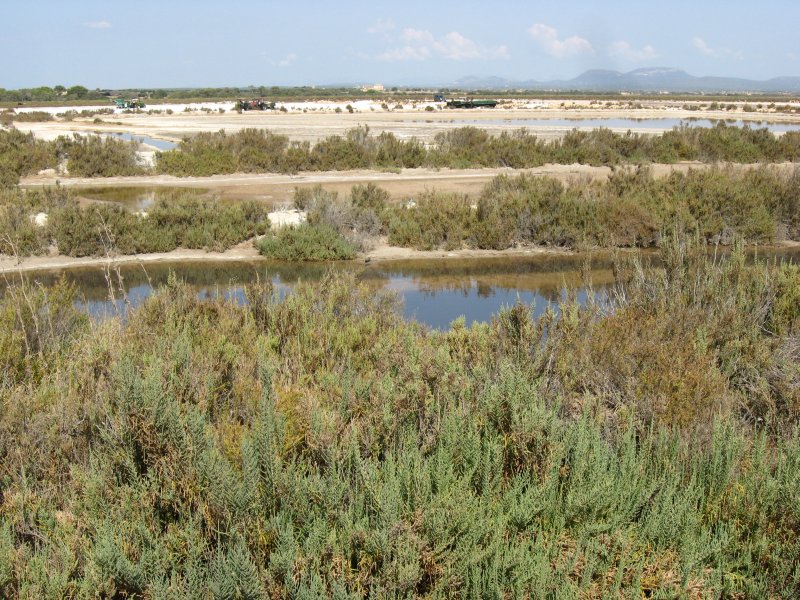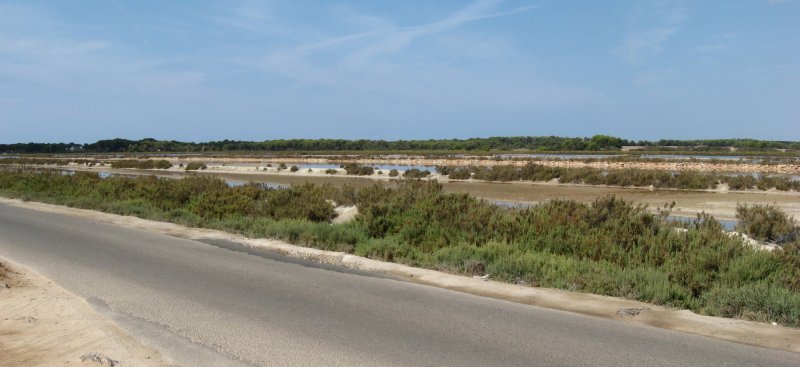 |
English version (German version below): |
First perform all tasks, second log the cache as a find!
Please log the cache when you have performed all required tasks (see below). Logs which only contain part solutions will be deleted without warning. Thank you for your understanding. |
The "Salines de Llevant" is the biggest and oldest solar salt evaporation pond on Mallorca. Salt evaporation ponds are shallow man-made ponds designed to produce salts from sea water or other brines. The seawater or brine is fed into large ponds and water is drawn out through natural evaporation which allows the salt to be subsequently harvested. The ponds also provide a productive resting and feeding ground for many species of waterbirds, including several endangered species. The ponds are commonly separated by levees.
At the above coordinates an industrial company is producing salt since 1850 (the first salt was produced here over 200 years ago). Every April seawater (salt content 4,7 gram per liter) is embed into quadratic ponds (so called "cocons" with 250 meters edge length). Around 130 hectare of synthetic salt lagoons every spring ( over 300 hectare 100 years ago). During the evaporation process in the summer the water is redirected into different ponds several times, in order to make the crystallization of the salt finer. Thereby the famous "Flor de Sal" is "gathered" by handwork. In September diggers remove the salt-crust. Afterwards the salt-crust is crushed and collected on high salt hills. After cleaning the salt is sold all over the world (every year around 8000 tonne).

Zum Vergrößern bitte Anklicken / click for enlargement
According to the saliniferous separation the following salt types are "products" of the oversaturated dilution: first of all gypsum/anhydrite. Gypsum is a very soft mineral composed of calcium sulfate dihydrate, with the chemical formula CaSO4·2H2O.
Afterwards rock salt (common salt). Halite is the mineral form of sodium chloride, NaCl, commonly known as rock salt. Halite forms isometric crystals. The mineral is typically colorless to yellow, but may also be light blue, dark blue, and pink depending on the amount and type of impurities. It commonly occurs with other evaporite deposit minerals such as several of the sulfates, halides, and borates.
At last potassium salt and magnesium salt. Potassium in nature occurs only as ionic salt. As such, it is found dissolved in seawater, and as part of many minerals. Potassium ion is necessary for the function of all living cells, and is thus present in all plant and animal tissues. It is found in especially high concentrations in plant cells, and in a mixed diet, it is most highly concentrated in fruits

Zum Vergrößern bitte Anklicken / click for enlargement
To log this earthcache, perform the following tasks:
- Go to N39° 21.022 E3° 00.664 or N39° 20.841 E3° 00.297. There please take optional a photo of you in front of the "Salines de Llevant". If you are there without any help, you can take a photo of your GPSr with readable coordinates instead.
- Go to the beach and take some seawater. Place it into the sun and follow as well as document the salt evaporation with some pictures.
 |
Deutsche Version: |
Erst die Aufgaben vollständig erfüllen, dann loggen!
Bitte loggt erst, wenn Du die Aufgaben (s.u.) vollständig erfüllt hast. Logs, die nur teilweise die Logbedingungen erfüllen oder den Hinweis beinhalten, dass die Bilder nachgereicht werden, werden ohne Vorwarnung gelöscht. Vielen Dank für Dein Verständnis. |
Die industrielle Salzgewinnung begann auf Mallorca 1850, als die Firma "Salines de Llevant" gegründet wurde. Dass Verfahren, was dabei zur Salzgewinnung verwendet wird, ist über 2000 Jahre alt und hat sich über die Jahrhunderte nicht geändert. Im April wird Meerwasser durch einen zwei Kilometer langen Kanal auf die künstlich angelegten Salzfelder (cuarteradas) gepumpt. Die cuarteradas sind miteinander verbunden. Sie erstrecken sich über ein Gebiet von rund 160.000 Quadratmetern. Jedes einzelne Feld misst 7100 Quadratmeter. In den Feldern beginnt der Prozess der Verdunstung und der Ausfällung des Salzes und verschiedener Mineralien. Ist ein Teil des Wassers verdampft, leitet man den Rest in Nähr- und schließlich in Kristallisationsbecken (entsprechend der salinaren Abscheidungsfolge fallen die Salze aus der übersättigten Lösung aus: zuerst Gips/Anhydrit, dann Steinsalz (Kochsalz), Kali- und Magnesiumsalze zum Schluss). Dort wird die Lauge mit einer erhöhten Konzentration an bitteren Kalium- und Magnesiumsalzen ab- und frisches Meerwasser zugeleitet. Ab August erntet man das Salz mit einem Wassergehalt von 4 %, das schließlich gewaschen, gemahlen oder gepresst sowie in zwei Sorten abgepackt in den Handel kommt. Die berühmteste Salzsort Mallorcas ist wohl das "Fleur de Sel". Insgesamt werden heute jährlich noch rund 8000 Tonnen Tafelsalz in diesem Privatgebiet gewonnen.

Zum Vergrößern bitte Anklicken / click for enlargement
Um diesen Earthcache zu loggen, erfülle bitte folgende Aufgaben:
- Gehe zu N39° 21.022 E3° 00.664 oder N39° 20.841 E3° 00.297. Mache hier bitte freiwillig ein Foto von Dir vor den Salines de Llevant. Falls du alleine bist, reicht auch ein Foto von deinem GPS mit lesbaren Koordinaten.
- Besorge Dir etwas Meerwasser und lasse es verdunsten, so dass das enthaltene Meersalz zurück bleibt. Dokumentiere den Prozess mit Fotos, die Du Deinem Log beifügst.
Quellen sowie weitere Infos zum Thema:
Wikipedia-Artikel über Salinen
